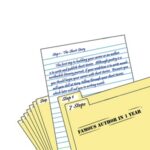You’ve worked hard on polishing your résumé. You’ve clearly defined your career objectives, you’ve shown off your impressive work history and you’ve included a set of references so hot they sizzle. But did you know that the look of your résumé can be just as helpful as the content? Hiring managers, human resources people, whatever you want to call them, they’re looking through hundreds of submissions, and if you can make yours stand out from the crowd before they’ve even read a word, so much the better!
(1) Don’t use a prepackaged résumé template! Chances are, your prospective employer has already looked through fifty submissions using the default settings that came with some word processor. You wouldn’t want to present yourself as a standard-issue employee, so why present a standard-issue résumé? Change the structure up a bit, sprinkle in a simple graphic element (even just small bullet points or a border), make the tabs different-something to make your work stand out from the crowd.
(2) Choose an attractive, professional font. The second should be easy enough to figure out-something readable, nothing gaudy or cutesy-but the first allows more leeway than you might expect. Boring old Times New Roman infests offices all over the country like termites, yet even the most bare-bones home computer these days comes with several attractive variations on basic serif type. Just for fun, try selecting all the text in your résumé and changing the font a few times to see how things look.
(3) But don’t get too creative with your font selections. In today’s electronic age, many times you’ll be asked to provide your résumé electronically. Ideally you’ll be able to provide a PDF, which will look the same on any computer, but if you have to provide an RTF or a Microsoft Word document, preserving the look of your résumé depend on the other party having the same fonts as you; if they do not have the font, it will go to a default, and text may spill about oddly and not line up properly. So whatever fonts you pick, make sure they are reasonably common to all computers, both Mac and PC. You may want to keep a separate version of your résumé with “dumbed-down” fonts just for this-for example, Macintoshes come with Helvetica, a lovely typeface, but for viewing on a Windows machine you’ll have to go with the less pleasing Arial.
(4) Good-looking typography is important, but part of that principle is restraint. One or two font selections will do; you want a clean, businesslike look, not a hodgepodge of typographic splendor.
(5) Watch the size of your text. Unless you are using an unusually-scaled typeface, your best bet for body text is size 10, 11 or 12. Too small is annoying to read, too large looks unprofessional.
(6) Are you using white space effectively? A page packed with text may suggest a lot of impressive accomplishments, but it’s also no picnic to read. A good résumé should be easy to scan and see what’s what. So use one-inch margins and leave line breaks between different kinds of information; ideally indent differently as well. Someone should be able to squint at your résumé and still be able to see what part is a job heading and what part is a description of what you did there. For an extreme example, check out a printed movie or television screenplay some time; there’s an awful lot of white space, but that’s why they read so quickly and excitingly. Résumés are rarely more than two pages, but that’s no reason why yours can’t feel like a page-turner!
(7) Don’t use underlines; we’re out of the typewriter era, and underlined text can be frustrating to read. If you’d like to emphasize something, use bold or italics instead. You can afford to be sparing with those as well-you are writing a professional document, not a comic book.
(8) Be consistent. If you bold “Objective”, bold “Education” and “Skills” as well.
(9) Use good paper-basic 20-lb. will do nicely. You do not want the summation of your professional life to feel flimsy in someone’s hands. But don’t get creative with paper choices-colors, card stock, odd textures and even scents have all been tried before, and all have done more harm than good.
(10) Laser printers are all quite common these days. This is all the more reason for you to use one. If you are stuck with inkjet, use the best print setting and let the ink dry before handling your document.
All this without mentioning the littlest fact about the actual content of your résumé! Just like your mother told you, appearances do count and first impressions are very important. With a little extra effort, your résumé can set you apart from the other applicants right from the moment your future boss opens the envelope. Good luck catching the eye of the right people at the right job for you!

